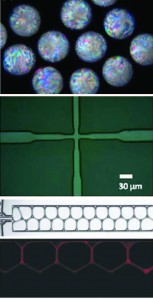 The annual APS March meeting was held last week at the convention centre in Dallas. The conference consisted of over 660 session and 7350 contributed talks (according to my rough calculation) on subjects ranging from quantum computing to the physics of evolution to polymer dynamics. Due to the shear number of talks, I will split the conference into a series of blogs rather than one long one, which no-one would want to read!
The annual APS March meeting was held last week at the convention centre in Dallas. The conference consisted of over 660 session and 7350 contributed talks (according to my rough calculation) on subjects ranging from quantum computing to the physics of evolution to polymer dynamics. Due to the shear number of talks, I will split the conference into a series of blogs rather than one long one, which no-one would want to read!
Deadly competition between sibling bacteria colonies – Avraham Be’er, University of Texas, Austin.
In this invited talk, Avraham Be’er discussed the growth of competing bacterial sibling colonies. A single colony of bacteria grows with radial symmetry at a constant speed. However, for two colonies of P. dendritiformis, equidistant from the centre and inoculated simultaneously, the dynamics differ. Initially the growth of each colony is radially outwards and independent of the other colony. However, while the distance is still large, growth in the centre, between the two colonies, decelerates and a gap forms between the two colonies. The colonies become asymmetric in shape and growth. (See Be’er’s website for pictures of the growing colonies.)
Be’er and co-workers have shown that the reason for this inhibition of growth is a toxic material secreted by the bacteria (doi:10.1073/pnas.0811816106). The toxin is lethal once it exceeds a well-defined threshold. Extracting the toxin and depositing it outside a growing single colony results in growth inhibition and cell death, which would otherwise not be seen. This toxin, termed ‘sibling lethal factor’ (Slf), lyses cells, rupturing them and is not limited to this bacteria (although the toxicity varies for different bacteria). The bacteria seem to have evolved to produce Slf and kill their own siblings, but only when there are two competing colonies. Slf is not secreted when there is only one colony.
Subtilisin was also found in the bacterial secretions. This protein is non-toxic. However, when Slf is exposed to subtilisin it is cleaved from a non-toxic protein of ~20 kDa to the toxic Slf ~12 kDa. The results suggest that subtilisin acts to regulate growth of the colony. Below a threshold value the subtilisin promotes growth and expansion of the colony. Above this threshold value Slf is secreted, reducing the density of cells (doi:10.1073/pnas.1001062107). The results also indicate that when the levels of Slf are small, rather than cell death occurring, the cells can instead enter a vegetative state. These vegetative cells ‘cocci’ are immobile, have a slow expansion and are spherical rather than rod-like in shape. These cocci cells are observed to switch back simultaneously and spontaneously to the healty rod-shaped cells, with growth continuing as before.
Related papers in Soft Matter
Variations in the nanomechanical properties of virulent and avirulent Listeria (doi:10.1039/B927260G)
Mechanical robustness of Pseudomonasaeruginosa biofilms (doi:10.1039/C0SM01467B)
Facile growth factor immobilization platform based on engineered phage matrices (doi:10.1039/C0SM01220C)











